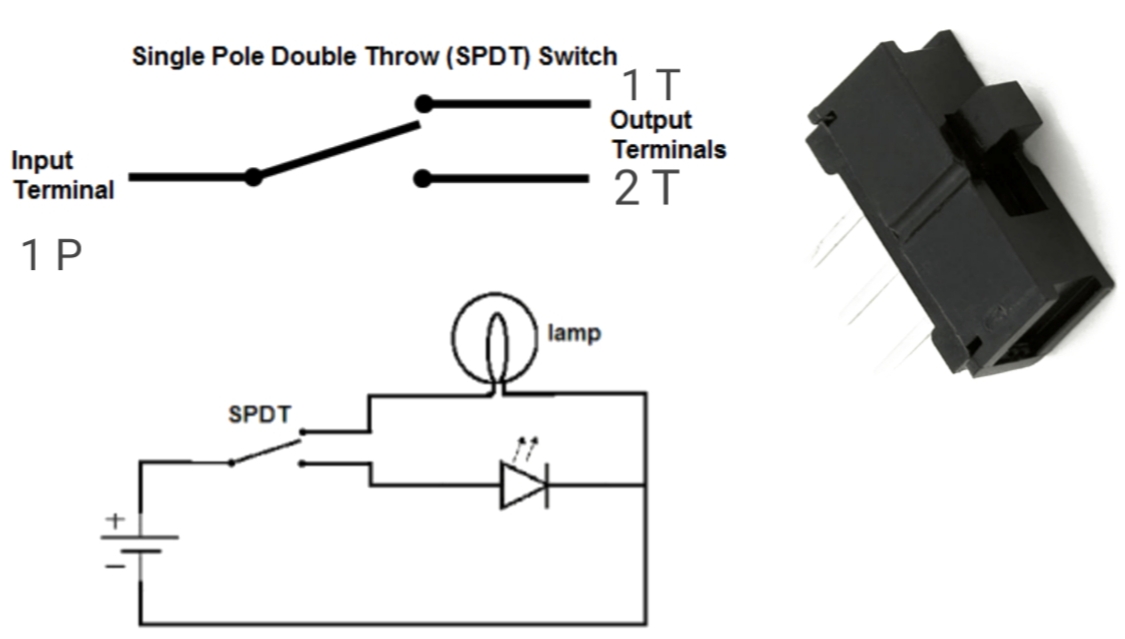Understanding the SPDT On-On Switch
Have you ever wondered about the magic behind a switch that allows you to control a circuit in two different ways? This is where the SPDT on-on switch, also known as a single-pole double-throw on-on switch, comes into play. These versatile electrical components are the backbone of many applications, offering a simple yet powerful way to manage the flow of electricity.
The SPDT on-on switch is a fundamental component in numerous electrical systems. Its unique ability to connect one input to one of two outputs makes it an essential part of various circuits, from simple household appliances to complex industrial machinery. Understanding its functionality is crucial for anyone working with electrical circuits.
So, what exactly is a single-pole double-throw on-on switch? Imagine a railway switch. A train can be directed down one track or another. An SPDT on-on switch works similarly, directing the flow of current to one of two possible circuits. The "on-on" designation indicates that the switch maintains a connection in either position. This distinguishes it from an SPDT on-off-on switch, which has a central off position.
The precise history of the SPDT on-on switch is difficult to pinpoint, but its development is intrinsically linked to the evolution of electrical switching technology in general. Early switches were often crude and unreliable, but with advancements in materials and manufacturing techniques, more sophisticated switching mechanisms like the SPDT emerged, paving the way for complex electrical systems.
The significance of the SPDT on-on switch lies in its versatility. It provides a simple and effective solution for controlling two separate circuits from a single point. This simplifies wiring and reduces the need for multiple switches. This versatility has led to its widespread adoption across numerous industries and applications.
A common issue related to SPDT on-on switches is incorrect wiring. Ensuring proper connections is critical for safe and reliable operation. Another potential problem is contact wear, which can lead to intermittent connections or complete switch failure over time.
The SPDT switch has a single input (the common terminal) and two outputs (the throw terminals). When the switch is in one position, the common terminal is connected to the first throw terminal. When the switch is toggled, the connection switches to the second throw terminal.
A simple example is using an SPDT on-on switch to control which of two lights is powered. The input would be the power source, and each output would be connected to a different light.
Benefits of SPDT On-On Switches:
1. Circuit Selection: Enables easy switching between two different circuits.
2. Simplified Wiring: Reduces the complexity of wiring compared to using two separate switches.
3. Compact Design: Occupies less space than multiple switches, making it ideal for space-constrained applications.
Best Practices for Implementing SPDT On-On Switches:
1. Proper Wiring: Ensure correct connections to prevent malfunctions or hazards.
2. Current Rating: Choose a switch with a current rating suitable for the intended application.
3. Environmental Considerations: Select a switch appropriate for the operating environment (e.g., temperature, humidity).
4. Quality Components: Use high-quality switches from reputable manufacturers for reliability and longevity.
5. Testing: Always test the circuit after installation to ensure proper functionality.
Real-World Examples of SPDT On-On Switch Applications:
1. Selecting between two different audio sources for a speaker system.
2. Switching between a main power source and a backup generator.
3. Controlling the direction of a DC motor.
4. Implementing a simple A/B switch for testing different audio signals.
5. Switching between two different antennas in a radio receiver.
Frequently Asked Questions:
1. What does SPDT stand for? Single-Pole Double-Throw.
2. What is the difference between on-on and on-off-on? On-on maintains a connection in both positions, while on-off-on has a central off position.
3. How do I wire an SPDT on-on switch? Refer to a wiring diagram specific to your application.
4. What is the current rating of an SPDT switch? It varies depending on the specific switch model.
5. Can I use an SPDT switch with AC and DC circuits? Yes, as long as the switch is rated for the voltage and current of the circuit.
6. What are common problems with SPDT switches? Incorrect wiring and contact wear are common issues.
7. Where can I buy SPDT on-on switches? They are available at most electronics stores.
8. How do I troubleshoot a faulty SPDT switch? Use a multimeter to check for continuity between the terminals.
In conclusion, the SPDT on-on switch is a versatile and essential component in a wide range of electrical applications. Its ability to select between two circuits makes it a valuable tool for simplifying wiring and controlling various devices. By understanding its functionality, applications, and best practices for implementation, you can harness the power of this simple yet effective switch to create efficient and reliable electrical systems. From controlling lights and appliances to managing complex industrial processes, the SPDT on-on switch continues to play a vital role in shaping the world around us. Its compact design, ease of use, and affordability make it a go-to solution for countless applications, and its enduring presence in the field of electronics speaks to its versatility and reliability. Understanding the principles behind the SPDT switch is an important step for anyone interested in electronics and electrical systems.
Decoding the iec relay coil symbol your guide to electrical control
Green smoke kitchens a timeless elegance
Anatomically correct heart tattoos with floral accents a blooming trend














